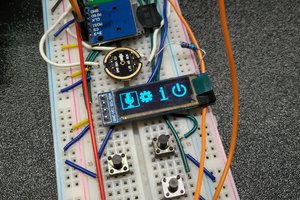Schematic:

As you can see, there is not a lot to it.
I'm using an ATTiny1617 because of its built in PTC (Peripheral Touch Controller). This makes using the capacitive touch buttons fairly easy since you can make use of the Atmel QTouch library. The RTC was mainly chosen because of its small size and built in oscillator.
Now to one of the most important parts of such a project, the battery life:
I've spent quite some time working on the software and making sure that current consumption is as low as possible in sleep mode. The hardest part was definitely getting the capacitive touch buttons / Atmel QTouch to work nicely in low power mode. In order for the capacitive touch buttons to work reliably, drifting has to be performed regularly. Which basicly means to perform an active measurement on the button regularly, to accommodate for changes in the environment and other things that could influence the reading of the button. The only problem was that this caused my average current consumption to go way higher, than what I was shooting for.
So now after a lot of testing and tweaking, I was monitoring the current consumption over around 24h and got an average of 8.7µA.
With a typical capacity of a Varta CR2032 (230mAh) this should give it a battery life of:
230mAh/8.7µA = ~26436h or ~1100 days in sleep mode as a best case scenario.
The current consumption in active mode is around 3 - 3.5mA. So of course, like with everything else, it highly depends on how often and how long it's turned on. But I'm quite happy with it.
Case:

I designed the case in Fusion360 to fit a standard 18mm nato strap and then 3D printed it in regular PLA.
To mount the PCB I made some slots into the mounting posts, which can hold M1.4 nuts. Then the PCB can be screwed in by 4 black M1.4 screws.
 Tobias
Tobias

 The black solder mask obviously fits the black 3D printed case much better, but nonetheless, this was a great first project to mill.
The black solder mask obviously fits the black 3D printed case much better, but nonetheless, this was a great first project to mill.






 David Boucher
David Boucher
 Maksym
Maksym
 AccidentalRebel
AccidentalRebel
 Peter Wasilewski
Peter Wasilewski
</s> </s> </s> </s> </s> </s> </s> </s> </s> </s> </s> </s> </s> </s> </s> </s> </s> </s> </s> </s> </s> </s> </s> </s> </s> </s> </s> orang </s>
wow, this is so amazing, i want to try to make it